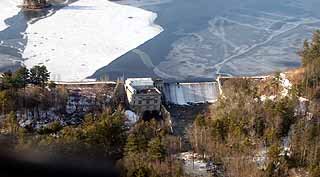
Surveys
DJC.COM
August 3, 2006
States keep their authority to regulate dams
Marten Law Group

Kray
|

Fandino
|
In May, the U.S. Supreme Court unanimously upheld states’ rights to place environmental conditions on hydropower licenses under the federal Clean Water Act, even where dams may not add any pollutants to downstream waters.
The decision, S.D. Warren v. Maine Board of Environmental Protection, is the first environmental law decision issued since Chief Justice Roberts and Justice Alito joined the Supreme Court. The dams and hydropower supervisor for the Maine Board of Environmental Protection called the S.D. Warren decision the most important hydropower case in 50 years.
Under the court’s decision, environmental agencies in Washington and other states may continue to approve, and place environmental conditions on, federally licensed or relicensed hydropower facilities. The states may regulate both water quality and quantity, and may include conditions requiring operators to provide minimum stream flows, maintain downstream water quality, construct fish passageways, and create recreational river access for fishing and boating.
In combination, such conditions could substantially increase direct costs for federal license applicants or holders and indirectly increase costs for consumers.
Case began during relicensing

Photo courtesy Friends of the Presumpscot River and Friends of Merrymeeting Bay S.D. Warren operates the Dundee Dam and four others on the Presumpscot River in Maine. It lost a case to bypass the state to get its dams relicensed. |
The case arose after S.D. Warren asked the Federal Energy Regulatory Commission (FERC) to renew federal licenses for five hydroelectric dams that it owns on the Presumpscot River in Maine. The company uses the dams to generate power for a paper mill. The dams operate in a run-of-river mode, where inflow approximately equals outflow; and water passing though the dam is impounded, passed though turbines, and then returned to the riverbed below.
During relicensing, S.D. Warren objected to a requirement that it obtain state water quality certificates to support its application. S.D. Warren argued that state approval for the licenses was not necessary since dam operations did not result in discharges into the river, which would invoke the need for state water quality protection.
S.D. Warren challenged FERC’s long-standing presumption that applicants for federal hydropower licenses must obtain water quality certificates from the state in which a dam is located to ensure that projects that may affect state water quality comply with state water protection laws. FERC based this presumption on the requirements of two federal laws.
The first law is the Federal Power Act, which requires federally issued licenses for the construction, operation and maintenance of hydroelectric dams on U.S. navigable waters, such as rivers, lakes and streams. Under the Federal Power Act, FERC must also relicense dams every 50 years after reviewing the demand for power, and environmental issues.
The second law is the federal Clean Water Act, particularly a section of that act which requires federal license or permit applicants to obtain state approval for projects that may result in a discharge into navigable waters.
What is a discharge?
Both sides focused their arguments on a single issue: whether water released from a dam may result in a discharge into the riverbed below. If dam operations result in a discharge, the Clean Water Act requires state approval of a federal license.
S.D. Warren, supported by numerous amici, or friends of the court — including hydropower, home builder, property owner and economic development interests — argued that dams do not result in a “discharge” into navigable waters, as the court has interpreted that word under the act. S.D. Warren based its assertion on a previous Supreme Court decision, South Florida Water Mgmt Dist. v. Miccosukee Tribe of Indians, which interpreted “discharge” under a different Clean Water Act section that governs discharges from point sources such as pipes and outfalls. In that decision, the court said a discharge requires an addition of a pollutant from a distinct water body.
According to S.D. Warren, dams do not add anything to the river, but merely retain water, and reintroduce that same water farther downstream. Accordingly, S.D. Warren argued that releases of water from dams should not be encompassed within the legal definition of a discharge.
The state of Maine disagreed with the company’s assertion that the state lacked authority under the Clean Water Act to place environmental conditions on Maine river dams. According to the state, a dam moves water from one side of the river to the other, and therefore results in a downstream “discharge,” as the term is understood in common parlance.
Maine further argued that the Supreme Court’s analysis in Miccosukee did not apply since that case interpreted the word “discharge” in a different context, and under a different provision of law. A number of environmental groups, states, Indian tribes and scientists agreed with the state’s arguments.
Decision's possible impact
The Supreme Court agreed with Maine. Relying on Webster’s Dictionary, the court decided that the common meaning of a water discharge means “flowing or issuing out” and, as used in the relevant portion of the Clean Water Act, does not require the addition of any pollutant or foreign substance to water.
The court also found that its analysis in Miccosukee was inapposite since the two Clean Water Act sections serve different purposes, and the meaning of the term “discharge” in achieving these purposes is not interchangeable.
Since the court found that releases of water from a dam might result in a discharge, the court preserved states’ authority to regulate water releases to rivers within a state. While the decision ultimately preserves the status quo, it disappointed many in the hydroelectric industry and business community who would prefer a more streamlined federal-only licensing process and greater regulatory consistency.
The S.D. Warren decision is particularly significant in the Pacific Northwest because Washington and Oregon, along with California, New York and North Carolina, are the top five states with dam licenses expiring between 2005 and 2015. Nationwide, the greatest amount of generating capacity will come up for relicensing in 2007.
Jeff Kray is a partner and Laura Fandino is an associate with Marten Law Group, a Seattle-based environmental law firm.
Other Stories:
- Mechanical engineers hop aboard the green bandwagon
- UW’s environmental strategy goes from grass roots to daily integration
- New rules for ‘innocent landowners’
- Washington banks on wetland mitigation
- Navigating our water right application process
- Tapping into a sea of power
- Orcas: the next killer environmental issue?
- Minimize data handling to reduce errors
- Solvent spill? Know your cleanup options
- Fish to fly past the ‘Kirkland crawl’
- Getting the creosote out of Puget Sound
- Green Factor would change urban landscape design
- Spokane does brownfields on a grand scale
- Plan ahead for the new stormwater permit
- Local environment benefits from oil spill
- Conservation program saves money, landfill space
- Education centers show how to tread lightly on the environment
Copyright ©2009 Seattle Daily Journal and DJC.COM.
Comments? Questions? Contact us.